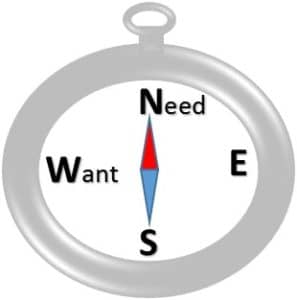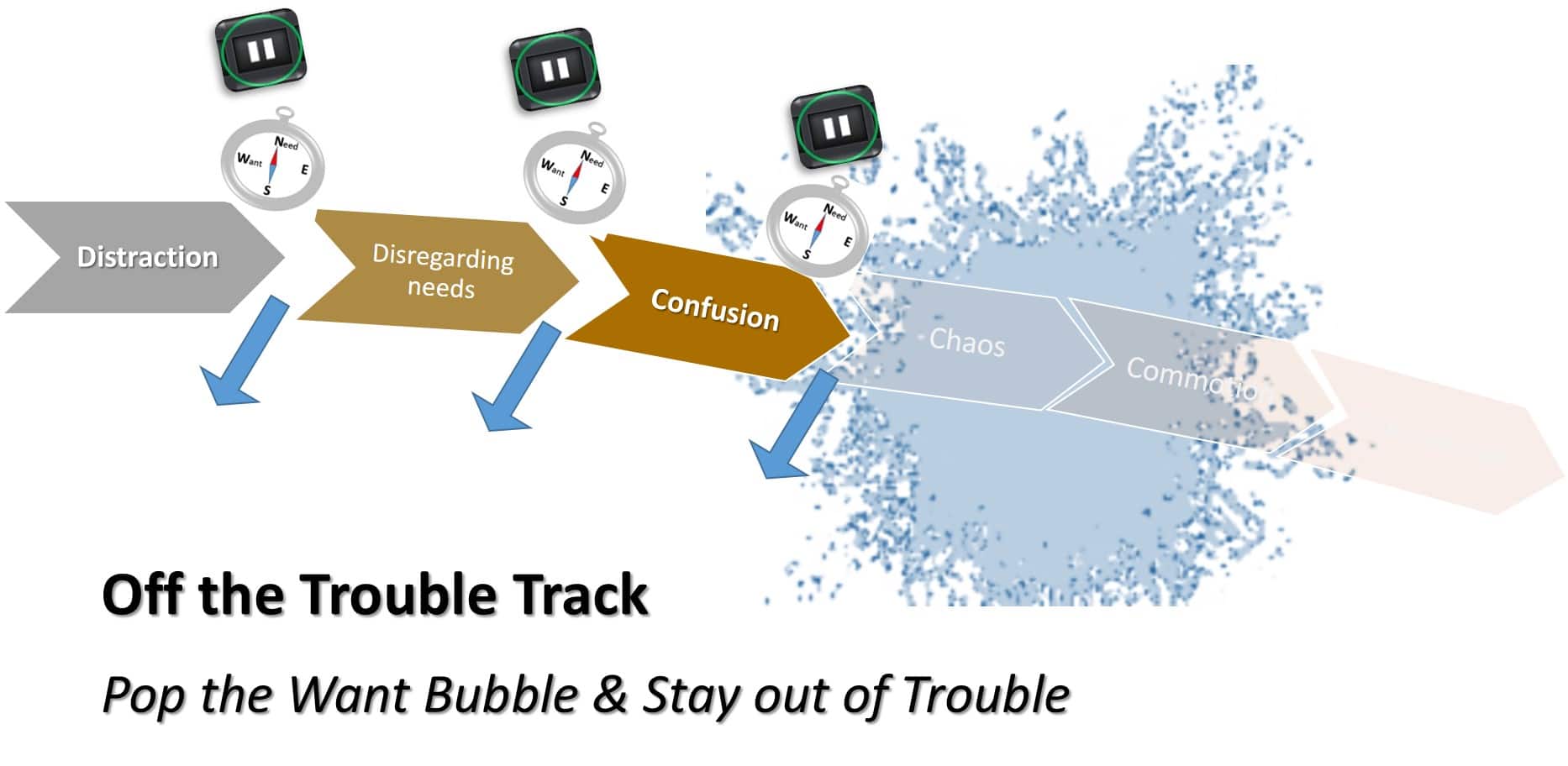Can parents help their child from getting into the want bubble at all?
They sure can! In fact, parents have at least 3 chances to help out their child before she slides down the trouble track. The stages are distinct and have gaps between them.
Give them 2 tools and a mantra! Use the tools to follow the mantra to escape the trouble track.
The tools
- The PAUSE Button
- Need/ Want Compass
The mantra
‘Pop the want bubble, and stay out of trouble.’
The two tools
Children, even the younger ones, respond to concrete and cryptic messages. They find it amusing and easy to remember. Red to Stop, Green to Go, Zebra for crossing, reading musical notes or following th beat, and for the younger – going down on ‘all fall down’ in ‘ring around the roses’, are all examples of codes established in their language.
Such a code is also very efficient and effective. There is no need to use a lot of words that may lead to argument and misinterpretation.
The two tools here will help you amuse, engage and enrol the child in the effort to stay off The Trouble Track.
- The Pause Button

Since it is essentially a distracted, over stimulated or tired child, in a busy, chaotic environment who is most vulnerabl to get onto The Trouble Track, it is best to find a moment or a breather.
This tool will help you grant and remind them (and yourself) to take that breather, literally.
Hit the ‘Pause Button’ and BREATHE!
Well, you don’t literally ‘hit’ the pause button, but rather tap or touch it.
During my talks, I ask children to find the ‘pause button’ to their mind;
‘If your forehead is the remote control to your mind, can you find the pause button on it.’
Once they ‘find’ it, parents please note that spot and reinforce it in good times on multiple ocassions so that the ‘pause button’ gets established in verbal and non verbal language with your child. Each child may have his pause button at a different spot on the forehead. And that is okay as long as ‘it works.’ It is important to test the pause button, in a lighter mood, a few times (not overdoing it) before you would actually need it.
To make it even more effective, find your own pause button! And when need be, remember to use your tool and remind your child to use his.
The ‘Pause Button,’ will be effective (on most ocassions) to restore a moment of calm, which would it easier to think rationally and use the second tool.
- Need/ Want Compass

The second tool can be applied, in the moment of calm (even if it is a moment).
The Need/Want compass should be used to point towards the True N (Need). Ask a simple question;
‘What do I (or you) NEED?
‘I get what you want, but help me understand what you need at this point.’
‘We don’t want to go Jay’s way in Beach Bungle. He got all that he wanted. But was he happy? Jay was happy when Jay got what he NEEDED.’
Parents’ common reaction to their child’s unreasonable behavior is taking a strict stance, reprimand with an intention to get the child (who is on The Trouble Track or inside a Want Bubble) to listen/ follow/ obey. But none of this happens as the child, from where he is, sees this expectation of him and his parent’s behaviour as unreasonable.
It is thus important at this point, for the parent to not react to the child but to use the Need/Want Compass and think ‘What she needs?’.
Parent is in a position to help the child only when the parent is in control of self, is calm and is able to focus on ‘child’s need’ and not on his action.

Off The Trouble Track
7-year-old Tia went around the airport shops with her grandparents. When she came back to the lounge after 30 minutes, she had a few key chain charms for her bag, a couple of Cambodia T shirts, a pair of flip flops, a few chocolates, pack of chips and other souveniers. She wanted a handbag – ‘the most amazing one’ – she had seen on the shelf. Tia kept nagging but her grandparents had run out of cash. So she had to come back to her parents for more. Her mother calmly asked her to sit down and look at the stuff she had bought. Then she asked Tia, ‘Do you want to play cards?. Tia agreed. At the time of boarding, nearly an hour later, mother asked Tia, ‘You did not really want that bag. Did you?’ ‘No, I was getting bored.’ Tia was travelling back home from Cambodia, with her family – all adults – parents and grandparents. After an hour long drive to the airport, an hour long wait at the check-in, and with more than an hour and a half to board her flight, Tia needed a break, some meaningful entertainment.

